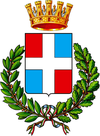Vittorio Veneto
| Vittorio Veneto | ||
|---|---|---|

|
|
|
| Country | Italy | |
| region | Veneto | |
| province | Treviso (TV) | |
| Local name | Vitòrio | |
| Coordinates | 45 ° 59 ′ N , 12 ° 18 ′ E | |
| height | 138 m slm | |
| surface | 82 km² | |
| Residents | 27,980 (Dec. 31, 2019) | |
| Population density | 341 inhabitants / km² | |
| Post Code | 31029 | |
| prefix | 0438 | |
| ISTAT number | 026092 | |
| Popular name | Vittoriesi | |
| Patron saint | San Tiziano, Santa Augusta | |
| Website | Vittorio Veneto | |
Vittorio Veneto is an Italian town in the province of Treviso the Region Veneto with 27,980 inhabitants (as of December 31, 2019).
The city is the seat of the Roman Catholic diocese Vittorio Veneto , whose cathedral Santa Maria Assunta is in the Cèneda district.
geography
The city is located in northeastern Italy on the edge of the northern Italian plain, at the foot of the southern Alps on the gravel of the terminal moraine of an Ice Age glacier , which can also be seen in the numerous sinkholes in the area. The city lies on the Meschio River , a tributary of the Livenza .
The A27 Venice - Ponte nelle Alpi (Alemagna) motorway runs past the city .
The neighboring municipalities are Belluno ( BL ), Cappella Maggiore , Colle Umberto , Conegliano , Farra d'Alpago (BL), Fregona , Limana (BL), Revine Lago , San Pietro di Feletto and Tarzo .
history
The city was founded on September 27, 1866 (confirmed by a royal decree of November 22, 1866) through the union of the towns of Cèneda (in the south) and Serravalle (in the north), initially under the name Vittorio (after King Victor Emmanuel II ). Only after the First World War did the city receive the honorary addition of Veneto in 1923, referring to the Veneto region .
During the First World War , the area of Vittorio Veneto northeast of the Piave was the scene of the last fighting between the armed forces of Austria-Hungary and Italy . At the end of October 1918, the Battle of Vittorio Veneto took place here, which ultimately led to the armistice of Villa Giusti near Padua on November 4, 1918. In Italy, the battle is the epitome of Italy's victory in World War I.
The high symbolic value of Vittorio Veneto in the Italian self-image is reflected, among other things, in the fact that large warships were named after Vittorio Veneto both in the fascist era and after the Second World War . In the 1930s one got battleship of the Littorio class was the first of the name, in the late 1960s, a aircraft cruiser , long time flagship of the Italian Navy was. In addition, an army brigade carried the name Vittorio Veneto in the 1970s and 1980s . Since 1968 there has also been a military order called the Vittorio Veneto Order ( Ordine di Vittorio Veneto in Italian ), which was awarded from the 50th anniversary of the battle to Italian veterans who had to have participated with distinction in the First World War for at least six months . The medal is practically no longer awarded.
During the Cold War, Vittorio Veneto was home to the command of the Italian V Corps , which had the task of preventing the Warsaw Pact armies from entering northeastern Italy. Even today, the city is the seat of a high army command ( COMFOD 1 ).
In 1988 the 21st and final stage of the Giro d'Italia ended in Vittorio Veneto with the victory of the Swiss Urs Freuler .
Personalities
- The famous opera librettist Lorenzo da Ponte came from Cèneda (now part of Vittorio Veneto).
- Albino Luciani, who later became Pope John Paul I , was Bishop of Vittorio Veneto from 1958 to 1969 .
- Bartolomeo Costantini (1889–1941), aviator and racing car driver
- Paolo Barison (1936–1979), football player and coach
- Vittorio Casagrande (1934–2008), German pop singer and actor
- Renato Longo (* 1937), cyclist
- Ilario Castagner (* 1940), football player and coach
- Gabriele Pin (* 1962), soccer player and coach
- Fabio Dal Cin (* 1965), Roman Catholic clergyman, archbishop and prelate of Loreto
- Mirco Lorenzetto (* 1981), racing cyclist
- Francesca Segat (* 1983), swimmer
- Andrea Poli (* 1989), soccer player
- Michele Fornasier (* 1993), football player
- Irene Casagrande (* 1996), actress
Web links
- Official website (Italian)
Individual evidence
- ↑ Statistiche demografiche ISTAT. Monthly population statistics of the Istituto Nazionale di Statistica , as of December 31 of 2019.



